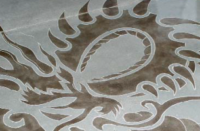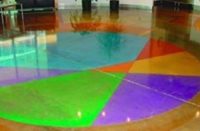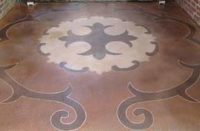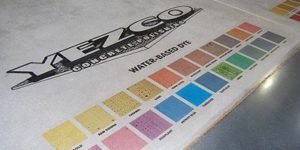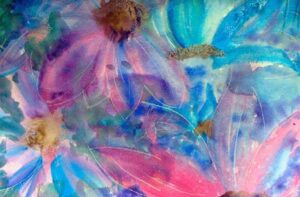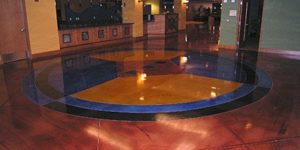Expectations of what a floor should look like will vary from client to client. A client’s views will be shaped by other stained floors seen in person or in photographs. Although all of these things can affect a client’s expectations, the greatest influence on their flooring decision should come from the concrete professional.
We find that selling a reactive-stained concrete floor is usually more difficult than completing the work itself! This may be because the same qualities that make reactive-stained concrete floors the most unique and desirable flooring option for some clients can be seen as flawed imperfections to others.
Customers who see the unique characteristics of reactive-stained concrete as flawed imperfections tend to resort to nonpayment or may discredit your company for poor craftsmanship. Neither of these results aid in the success of your business. So I will provide you with tips for setting reasonable expectations for your customers, enhancing your selling experience and delivering a quality product.
Inform your client
First and foremost, when initiating the sale of a concrete floor it is important that you inform your clients of the characteristics and features of reactive-stained concrete before you deliver the final product.
I like to use the term “reactive stain” instead of “acid stain.” I’ve noticed that some clients can get hesitant or worried when I use the word “acid” around them. Other clients already have a slight idea of what acid stain is.
Many who are unfamiliar with the concrete industry get reactive-stained concrete confused with other concrete systems. Clients confuse sealing, staining, and painting concrete. It is our job as concrete professionals to spread the word about the different concrete products that exist in our industry. There are also many different variations of similar products sold by different companies, making all of this very confusing to the layperson. Educating your client may help them get closer to the goal of their finished space and can save you headaches along the way.
You should also help your client understand which treatment is best for the existing condition of their concrete. Explain that exposure to moisture, sunlight, heat and other external elements can greatly affect the stain and concrete reaction. Nicks, cracks, patches and spots where items have laid on the concrete can also enhance or deter the stain’s reaction.
Help your client visualize
Having artistic backgrounds, many concrete stain masters can visualize and predict the end product. Many customers, however, lean on the professionals for assistance with visualization. The visualization process is part of setting customer’s expectations and can keep clients from getting a sour taste in their mouths.
In order to help your customer visualize the end product, you may want to provide them with stain samples during the initial project consultation. These samples can show some of the color shifting and variations that reactive concrete stains are known for. These samples give a client something to touch and feel.
I like to make my samples at least 2 feet by 1 foot so the client can see the color in a large piece. This gives clients a better idea of how reactive stain produces movement and marbling effects. A stain sample that I particularly enjoy showing customers shows a weathered copper patina. This sample’s color shifts from a light bronze to a hazy green and shows the client how different colors can be used and transitioned.
No matter how many samples you make for the client, it is still important to tell him or her that you cannot promise that the exact color on the sample will appear on their newly stained floor. Before proceeding with any job, always do a color test directly on the client’s concrete. You can complete this color sample in an inconspicuous spot, such as in a closet, so that it can by easily covered up if the stain reacts differently from the sample.
When performing the sample tests you are still setting up the client’s expectation for the final floor. Point out existing flaws in the concrete such as trowel marks, surface changes and patched spots. Make sure your client knows that all of these features as well as spots that have been “covered up” or “fixed” in the past will become even more pronounced once the concrete stain is applied. These features will add to the mottled effect of the stain reacting with the concrete, and they are what make the finished stained concrete a unique piece of art, but not all clients see these features as desirable.
Stained concrete should be as unique to a space as the artist’s brush stroke is to his or her canvas. If every stain reacted the same, reactive-stained concrete would lose its sought-after, one-of-a-kind characteristics — but make sure these characteristics are desirable for your client.
Along with providing samples my company also likes to provide clients with photographs of past stain projects. Make sure you visually document your work after each job so that you can help your future clients see a finished reactive stain project. A picture portfolio is the best way to show a client how much stain can vary on one floor.
If the client seems unsure of the product, do not continue with the work. They must feel confident in your abilities if they are to be truly satisfied with the end product. If your client is ultimately looking for an even color on their concrete, acid-stained concrete may not be the best solution.
Always remember too that, although pictures are a great tool for visualization, the client’s floor will not look exactly like the photograph. I once had a client who wanted a floor to look just like one of the pictures on my website. The picture was of a job finished with a stained white overlay, but my new client was not interested in doing an overlay and wanted to use the existing concrete surface. The client’s surface was dark gray and had curing marks from lumber that had laid on the slab right after it was poured. I had to explain the differences between their concrete surface and the one in the photo.
We settled on colors by completing physical samples on-site. By setting exceptional expectations with the client I left the final project with a satisfied customer and a great customer review for my website.
